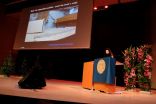Shedding new light on the formation of emotional fear memories
2014-12-08
(Press-News.org) Everyday events are easy to forget, but unpleasant ones can remain engraved in the brain. A new study published in the Proceedings of the National Academy of Sciences identifies a neural mechanism through which unpleasant experiences are translated into signals that trigger fear memories by changing neural connections in a part of the brain called the amygdala. The findings show that a long-standing theory on how the brain forms memories, called Hebbian plasticity, is partially correct, but not as simple as was originally proposed.
The effort led by Joshua Johansen from the RIKEN Brain Science Institute in Japan and New York University scientists Lorenzo Diaz-Mataix and Joseph LeDoux, tested an influential theory proposed in 1949 by the Canadian psychologist Donald Hebb that neurons that are connected and fire electrical impulses at the same time increase the strength of their connections to form a memory. Previous work in reduced brain preparations had demonstrated that this process, called Hebbian plasticity, can increase the connection strength between neurons, but it remained untested during memory formation in behaving animals. To directly test this question, the team examined whether coincident electrical excitation of neurons which are known to store fear memories is necessary and sufficient to trigger changes in neural connections and memory formation.
The researchers used a technique called optogenetics to silence electrical activity in a brain area called the amygdala where fear memories are stored, as animals learned to associate an auditory tone and mild electrical shock. In accord with Hebbian theory, silencing electrical activity reduced memory formation and the prevented strengthening of the connections between auditory neurons and amygdala cells.
However, when they eliminated the shock and replaced it with optical excitation of amygdala neurons, no learning occurred. Surprisingly, learning was restored when cell surface receptors for a neuromodulator called noradrenaline, which is important for attention, were activated at the same time. The results demonstrated that Hebbian mechanisms are important but not sufficient for memory formation, but require concurrent activation of noradrenaline.
According to Johansen, "This work represents one of the first tests of an influential hypothesis for memory formation in the working brain. The findings from this work support the general premise of the hypothesis, but suggest that other factors such as noradrenaline are also crucial." The study provides a new perspective on how aversive experiences, such as being attacked by a dog, for example, are translated by the brain into emotional fear memories and may represent a general process to control memory formation in other brain areas. In a broader context, the ability to precisely control of fear memory may help to treat them when they are medically deleterious in conditions such as fearful anxiety or post-traumatic stress disorder.
INFORMATION:
ELSE PRESS RELEASES FROM THIS DATE:
2014-12-08
A new genetic therapy not only helped blind mice regain enough light sensitivity to distinguish flashing from non-flashing lights, but also restored light response to the retinas of dogs, setting the stage for future clinical trials of the therapy in humans.
The therapy employs a virus to insert a gene for a common ion channel into normally blind cells of the retina that survive after the light-responsive rod and cone photoreceptor cells die as a result of diseases such as retinitis pigmentosa. Photoswitches - chemicals that change shape when hit with light -are then ...
2014-12-08
CAMBRIDGE, Mass. (December 8, 2014) - Long known for its ability to help organisms successfully adapt to environmentally stressful conditions, the highly conserved molecular chaperone heat-shock protein 90 (HSP90) also enables estrogen receptor-positive (ER+) breast cancers to develop resistance to hormonal therapy.
This HSP90-mediated evolutionary mechanism of drug resistance, reported by Whitehead Institute scientists in this week's online edition of the Proceedings of the National Academy of Sciences (PNAS), provides a strong therapeutic rationale for combining HSP90 ...
2014-12-08
Two-dimensional (2D) layered materials are now attracting a lot of interest due to their unique optoelectronic properties at atomic thicknesses. Among them, graphene has been mostly investigated, but the zero-gap nature of graphene limits its practical applications. Therefore, 2D layered materials with intrinsic band gaps such as MoS2, MoSe2, and MoTe2 are of interest as promising candidates for ultrathin and high-performance optoelectronic devices.
Here, Pil Ju Ko and colleagues at Toyohashi University of Technology, Japan have fabricated back-gated field-effect phototransistors ...
2014-12-08
Hummingbirds' remarkable ability to hover in place is highly contingent on the tiny bird having a completely stationary visual field, according to University of British Columbia research published in the Proceedings of the National Academy of Sciences.
UBC zoologists Benjamin Goller and Douglas Altshuler projected moving spiral and striped patterns in front of free-flying hummingbirds attempting to feed from a stationary feeder.
Even minimal background pattern motion caused the hummingbirds to lose positional stability and drift. Giving the birds time to get used ...
2014-12-08
A new advance in biomedical research at the University of Leicester could have potential in the future to assist with tackling diseases and conditions associated with ageing - as well as in treating cancer.
The research, which has shown promise in clinical samples, has been published in the prestigious scientific journal, Cell Death and Disease.
The group of scientists coordinated by Dr Salvador Macip from the Mechanisms of Cancer and Ageing Lab and the Department of Biochemistry of the University of Leicester carried out the study to find new ways of identifying old ...
2014-12-08
You don't have to be a jerk to come up with fresh and original ideas, but sometimes being disagreeable is just what's needed to sell your brainchild successfully to others. However, difficult or irritating people should be aware of the social context in which they are presenting their ideas. A pushy strategy will not always be equally successful, warn Samuel Hunter of Pennsylvania State University and Lily Cushenbery of Stony Brook University in the US, in an article in Springer's Journal of Business and Psychology.
People are often labelled as jerks if they are disagreeable ...
2014-12-08
CAMBRIDGE, MA -- MIT chemists have devised a new way to wirelessly detect hazardous gases and environmental pollutants, using a simple sensor that can be read by a smartphone.
These inexpensive sensors could be widely deployed, making it easier to monitor public spaces or detect food spoilage in warehouses. Using this system, the researchers have demonstrated that they can detect gaseous ammonia, hydrogen peroxide, and cyclohexanone, among other gases.
"The beauty of these sensors is that they are really cheap. You put them up, they sit there, and then you come around ...
2014-12-08
Researchers have long wondered if there is an upper limit to our capacity to store memories and how we manage to remember so many events without mixing up events that are very similar.
To explore this issue, researchers at the Norwegian University of Science and Technology's (NTNU) Kavli Institute for Systems Neuroscience and Centre for Neural Computation and colleagues from the Czech Republic and Italy tested the ability of rats to remember a number of distinct but similar locations. Their findings are published in the 8 December edition of the Proceedings of the National ...
2014-12-08
Technology that can map out the genes at work in a snake or lizard's mouth has, in many cases, changed the way scientists define an animal as venomous. If oral glands show expression of some of the 20 gene families associated with "venom toxins," that species gets the venomous label.
But, a new study from The University of Texas at Arlington challenges that practice, while also developing a new model for how snake venoms came to be. The work, which is being published in the journal Molecular Biology and Evolution, is based on a painstaking analysis comparing groups of ...
2014-12-08
(BOSTON and CAMBRIDGE, Massachusetts) - One of the reasons cancer is so deadly is that it can evade attack from the body's immune system, which allows tumors to flourish and spread. Scientists can try to induce the immune system, known as immunotherapy, to go into attack mode to fight cancer and to build long lasting immune resistance to cancer cells. Now, researchers at the Wyss Institute for Biologically Inspired Engineering and Harvard's School of Engineering and Applied Sciences (SEAS) show a non-surgical injection of programmable biomaterial that spontaneously assembles ...
LAST 30 PRESS RELEASES:
[Press-News.org] Shedding new light on the formation of emotional fear memories





